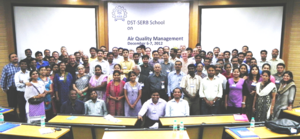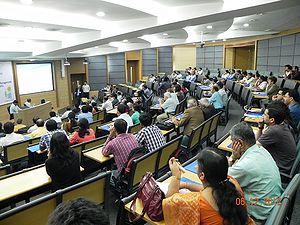Mumbai Air Quality Short Course/Course Content
Return to Short Course Home
December 6, 2012 (Day 1 Summary, R. Kumar)
09:00-10:00AM: Registration, tea/coffee
10:00-10:30AM: Inaugural Session
- Dr. Anil Dikshit, Indian Institute of Technology Bombay: Welcome to SERB School
- Dr. A.K Suresh, Indian Institute of Technology Bombay: MAGEEP Educational Network
- Dr. Virendra Sethi, Indian institute of Technology Bombay: Introduction to India Air Quality Resource Group
- Mr. Rajeev Mittal, MS of Maharashtra Pollution Control Board
- Dr. Rudolf Husar, Washington University in St. Louis: Mumbai AQ course rationale, goals, approach, expected outcomes
The Course will focus on the monitoring and assessment of air quality over India with emphasis on particulate matter. First the current state of monitoring and assessment will be presented by Indian air quality managers followed by lectures on the experiences in other countries. The results of satellite observations will be covered in more detail including tutorials on remote sensing and the DataFed analysis tools. Further lectures will cover organic aerosols, network design and focused monitoring issues. A panel discussion session will focus on the practical issues of monitoring and assessment in India. The event will conclude by charting of a roadmap for collaborative research and education in air quality monitoring and assessment using shared tools and information resources
10:30AM-1:00PM: AQ Monitoring and Assessment in India
Session Chair: C.V.C Rao, NEERI Nagpur
- Dr. Ajay Deshpande, Maharashtra State Road Development Corporation. Development and Augmentation of Ambient Air Quality Network in Maharashtra
- Dr. Gufran Beig, Indian Institute of Tropical Meteorology. System of Air Quality Weather Forecasting and Research (SAFAR)
- V.N Motghare, Maharashtra State Pollution Control Board. State perspective on monitoring and assessment, CEPI'
- Dr. R.N.Singh, INSA. Future of air quality modelling for sustainable development
1:00-2:00PM: Lunch
2:00-4:00PM: Ambient Monitoring and Assessment: Experiences from Other Countries
Session Chair: Dr. A.L. Aggarwal
- Dr. Orhan Yenigun, Bogazici University: A review of the surface ozone and its precursor concentrations in the megacity of Istanbul
Ozone is a secondary air pollutant originating via photochemical dissociation of nitrogen dioxide coupled with a reaction in which oxygen molecules combine with oxygen atoms generated from the dissociation. It is specific air pollution problem in urban ares with dense highway traffic. In this particular study, ozone and NOX measurements from three stations of different settings (urban, semi-urban and rural)in the megacity of Istanbul are compared. HYSPLIT trajectories and cluster analysis has shown that ozone is transported to Istanbul from the Balkans and Eastern Europe.
- Dr. Jay Turner, Washington University, Monitoring Network Design - Approaches and Lessons from the United States, Hong Kong, and Mongolia
Air monitoring networks can serve a range of data needs including, but not limited to, determining compliance against air quality standards, assessing spatial and temporal trends, identifying and quantifying source-receptor linkages, supporting atmospheric science and health effects studies, and evaluating the performance of pollutant transport models. This presentation will focus on the U.S. monitoring networks for ambient particulate matter mass and species. The evolution of these networks over time provides lessons that can be used to inform the design of new networks. Networks in Hong Kong and Ulaanbaatar, Mongolia, will also be briefly discussed.
4:00-4:30PM: Tea Break
4:00-6:30PM: Remote Sensing and Modeling Results for PM over India
Lecturers
- Dr. Rudolf Husar, Washington University in St. Louis,Remote Sensing and Modeling of PM over India
- Dr. Harish Gadhavi, NARL, Indian Space Research Organization (ISRO), Aerosol Characteristics in Rural Environment
Aerosol remote sensing basics
Satellite sensors: MODIS, OMI, CALIPSO, MISR
Global and regional modeling basics
Naval Aerosol Analysis and Prediction System (NAAPS)
Air quality patterns over India from satellites and models
6.30PM-7.00PM: Poster Session
7:00-8:00PM: Networking, Informal meetings, Dinner
December 7, 2012 (Day 2)
09:00-09:30AM: Summary report of Day 1
- Dr. Rakesh Kumar, National Environmental Engineering Research Institute, Mumbai, Summary of Day 1
9:30-10:30AM: Data Resources & Analyses Tools
Lecturers:
- Dr. Rudolf Husar, Washington University in St. Louis, Introduction to DataFed
- Ratish Menon, Indian Institute of Technology Bombay
Key Datasets; observing methods; parameters; space-time coverage
Surface and point monitoring networks
Satellite datasets and parameters
Models and emissions
Analyses Tools
Spatial and temporal pattern analyses
Event monitoring consoles
Special: Data fusion and model evaluation
10:30-11:00AM: Tea Break
11:00AM–12:45PM: Track 1: DataFed Tutorial
Dr. Rudolf Husar, Ratish Menon
Hands on tutorial on the federated data system (DataFed). Participants are encouraged to bring their own laptops.
11:00AM–12:45PM: Track 2: Strategic Planning Session on AQM
(a) Monitoring & Emission Inventory, (b) Health Exposure, (c) Modelling Data Interpretation (d) Control Management
A.B. Gupta, Amita Athawale, Akshara Kaginalkar, Rishi Agarwal, Subodh Maiti, Indrani Gupta, Sandeep Mishra, Anil Kumar, Anjali Srivastava,Seema Unnikrishnan, G.G Pandit
12:45 – 2:00 pm Lunch
2:00-3:15PM: Urban Measurements, Supersites, Special Monitoring
- Dr. Jay Turner, Washington University in St. Louis: Building a Conceptual Model for PM over Hong Kong: A Weight-of-Evidence Approach to Evaluating Source Apportionment Results
In collaboration with the Hong Kong University of Science & Technology, our group has been developing a conceptual model for ambient particulate matter over Hong Kong. The analyses capitalize on more than a decade of PM mass and species data from a multisite network across the Hong Kong SAR. Source apportionment modeling results were critically evaluated using complementary information such as emissions inventories and air mass trajectory analyses. PM mass data proved to be very useful corroborative information after we developed an understanding, from the other analyses, of patterns to examine in these data.
- Dr. Brent Williams, Washington University in St. Louis: Atmospheric Organic Aerosol: More Than Primary Emissions
3:15-4:00PM: Tea and Panel Discussion: AQ monitoring and analysis opportunities for India
Moderators:
- Rashmi S. Patil, Indian Institute of Technology Bombay
- Rakesh Kumar, National Environmental Engineering Research Institute
Panelists:
- A.L Aggarwal, Consultant
- Niraj Sharma, Scientist, Central Road Research Institute
- Sanjiv Kumar, Delhi Pollution Control Committee
- S. Pushpavanam, Indian Institute of Technology Madras
- Jay Turner, Washington University in St. Louis
- Rudolf Husar, Washington University in St. Louis
4:00-5:00PM: Roadmap Discussion
Charting a three year calendar for collaborative research and education in air quality monitoring and assessment using shared tools and information resources.

